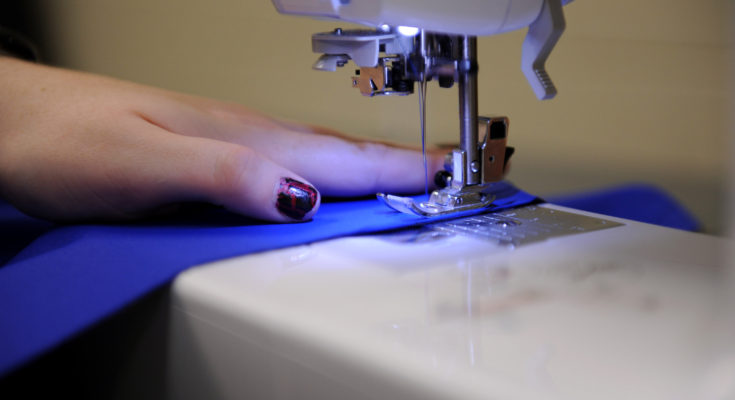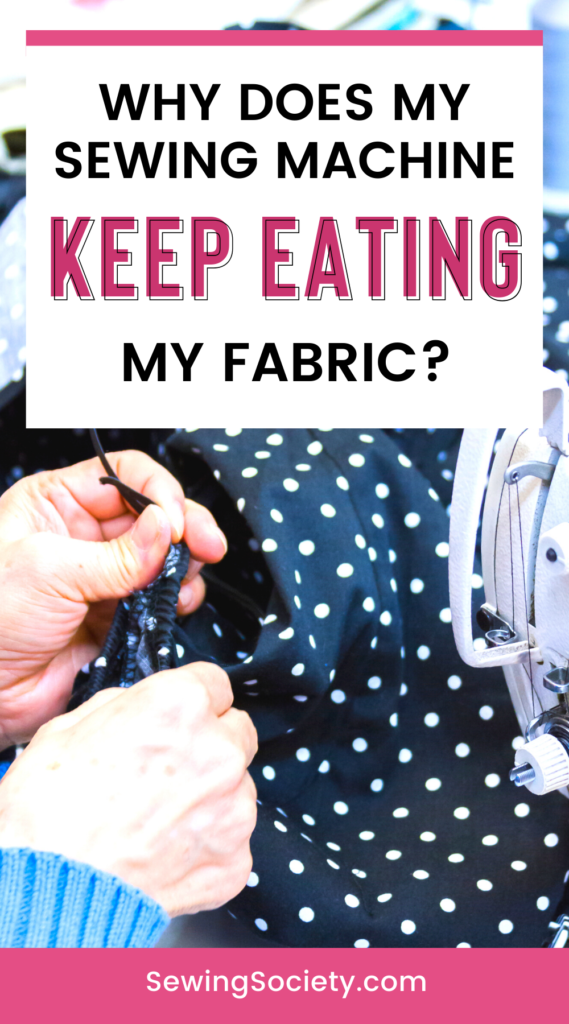Disclosure: This post may contain affiliate links. I earn a small commission when you click a link and make a purchase. Thanks for supporting SewingSociety.com!
Caution: Don’t just yank your fabric out of your sewing machine if it gets sucked under your needle plate because this can damage both your machine and your fabric. Carefully cut your threads until you can get your fabric out. If you’re lucky, your fabric won’t be damaged beyond repair. It helps to use a small pair of pointy scissors.
Sometimes those pesky feed dogs can eat your fabric… I’m sorry if this keeps happening to you. Let me help you figure out why. Here are eight reasons why your sewing machine can eat your fabric, and what to do about each one.
Contents
Your Sewing Machine Is Not Threaded Correctly
Even people who have been sewing for years sometimes thread their sewing machines incorrectly. This is the first thing you should check if your stitches do not look right or your machine keeps eating your fabric.
Unthread your sewing machine and rethread it from the beginning. Ensure your thread take-up lever is in its highest position, attach your spool of thread, and then pull your thread through your tension discs and thread guides according to the instructions in your user manual. Then, pull your thread through the eye of your needle and leave a four-inch tail of thread.
You Are Not Using the Correct Needle
Sewing machine manufacturers recommend that you change your needle before every project. That way your needle is sharp and can pierce your fabric easily. Dull needles can get caught on your fabric and break or push your fabric under your needle plate. This is more likely to happen when you’re sewing through thick fabric like corduroy or denim. Leather is so thick it requires a special needle.
Keep in mind that certain fabrics require certain types of needles. For example, a ballpoint needle is better for knit fabric than a sharp needle because it won’t snag and make your fabric run. If in doubt, use a universal needle.
Your Needle Is Damaged, Bent, or Dull
Over time, your sewing machine needle can get damaged or bent, especially if you are sewing through thick fabric. If your needle gets too bent, it can hit your feed dogs, throat plate, or bobbin case, and break. It can also push your fabric under your needle plate.
Sewing machine needles also have natural flaws or burs that happen during manufacturing. This means that you will occasionally come across a needle that is bent or damaged before you insert it into your machine. This isn’t very common, but it does happen. It’s a good idea to have replacement sewing machine needles on hand.
Your Feed Dogs Are Not Up
The teeth that stick up from your needle plate are called the “feed dogs.” They pull your fabric through your sewing machine. You can lower your feed dogs for freehand sewing, but most of the time you should have them up. If you forget to raise your feed dogs, your fabric will not move through your sewing machine properly and can get sucked under your needle plate. Make sure your feed dogs are up, sharp, and working properly. The lever to raise and lower your feed dogs is typically under your needle plate near your bobbin case.
Your Bobbin Is Full of Lint
Lint builds up in your bobbin case as you sew. It can get in the way of your needle and prevent the hook in your bobbin case from forming stitches properly. Clean your sewing machine frequently to ensure your fabric doesn’t get sucked under your needle plate.
You Are Not Using the Correct Stitch Length for Your Fabric
Your sewing machine has several stitch length, width, and design options. Not all of them will work with every type of fabric you sew. If your stitch length is too short, it can jam your machine and push your fabric under your needle plate. The same thing can happen if your stitch length is too long. Use a scrap piece of fabric to test which stitch length and width works best with the fabric you are using.
You Are Not Using a Straight-Stitch Needle Plate
The needle plate that comes with your sewing machine has a wide opening to accommodate both straight and zigzag stitches. Some sewing machine manufactures also sell a straight-stitch only needle plate. If your sewing machine keeps eating your fabric, you can try using a straight-stitch plate because there is less space for your fabric to get sucked in.
Your Fabric Is Too Stretchy, Slippery, or Thin
Fabric comes in different weights and textures, and each one acts differently in your sewing machine. If you are sewing on stretchy, slippery, or thin fabric, your feed dogs have more difficulty grabbing it and pulling it through your sewing machine. This can cause your sewing machine to suck your fabric under your needle plate. Use interfacing or a stabilizer to help your feed dogs move more difficult fabric smoothly through your sewing machine. You can also use a walking foot attachment.
If your fabric is being pulled into your sewing machine near the beginning of a new stitch, you can try using a paper starter. Sew a few stitches on a piece of paper and then feed your fabric into your sewing machine after. Also, don’t start sewing close to the edge of your fabric.
Also Read: How to Sew Stretchy Fabric Without Losing Your Mind
Did you find this article helpful?
I can help you solve other sewing machine problems, too! Get a copy of my book, Sewing Machine Problems and How to Solve Them on Amazon.
Your sewing machine is going to give you troubles again.
It’s inevitable…
My troubleshooting book walks you through how to solve the 20 most common sewing machine problems. You’ll be prepared to tackle any problem your sewing machine throws at you. That means more time sewing and less time crying.
The ebook version only costs $2.99. You’d easily pay between $75 and $150 to take your sewing machine to a repair technician. Learn how to do a lot of the sewing machine troubleshooting yourself and save money. For more information, visit our Sewing Machine Troubleshooting Page.
Share this post on Pinterest!







Another cause of fabric-eating is that the fabric is too narrow for the feed dogs to properly engage the fabric and pull it forward (or backward).
My BabyLock Altair is high end and never eats my fabric. But a tiny Elnita sewing machine I bought to take to a class situation really does. Thanks for your good ideas. Maybe I will need to take it back and exchange it or sell it for one with a choice of plates.